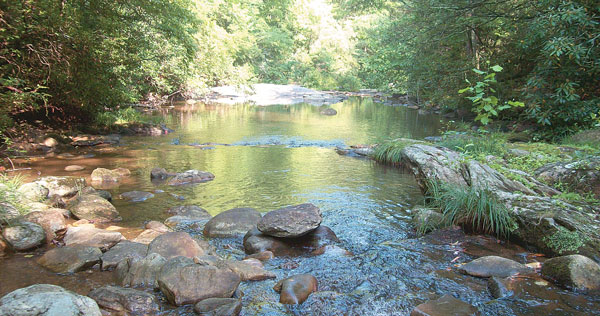
Jacob Fork is somewhat of an anomaly. It is a foothills stream with the characteristics of a high-mountain trout stream. It rises in southern Burke County and flows northeast into Catawba County where it joins Henry Fork to form the South Fork of the Catawba River.
The most-interesting section of the stream runs through South Mountains State Park. From Shinny Creek (pronounced Shiny) to the lower park boundary, Jacob Fork is delayed-harvest waters. Elsewhere in the park, the stream is regulated as wild-trout waters. The lower section of the stream, with its wide-open stream bed, is ideal for fly-fishing. This portion of the stream has numerous plunge pools and riffles. A well-maintained trail beginning at a large parking area above the park’s campground provides easy access to the stream. As you move higher, though, fishing becomes more difficult. The stream bed is riddled with huge boulders, some big as storage sheds. In several areas, slides have choked the stream with giant boulders. The stream courses under and around the boulders, creating some nice pools and runs, but it takes some climbing over the rocks to get to them.
The delayed-harvest section is stocked in April, May and June. It receives a bonus stocking in October and November. Total stocking numbers are 10,000 trout: 4,000 rainbow, 4,000 brook and 2,000 brown. Jacob Fork is a popular stream, and its stocked trout usually are fished out by the end of June. During July, August and September, you may find an occasional stocked straggler. I fished the stream in late August and didn’t catch a single trout in the delayed-harvest section. I did have better luck in the wild-trout portion of the stream, but they were small rainbows and obviously hungry. They constantly nipped at my fly, but some were too small to take it. The largest fish I caught was six inches. The small fish were fun to catch, fighting like fish twice their size.
About 2½ miles above the parking lot is High Shoals Falls. A spectacular wide sheath of water drops 80 feet over a huge, shear, rock face. It is not an easy climb to the falls, but it’s well worth the effort.
In addition to Jacob Fork and Shinny Creek, the park also has a section of Henry Fork, which is designated as catch-and-release/artificial lures-only water. From the lower park boundary, to SR 1405 at Ivy Creek, Henry Fork is hatchery-supported waters.
Anglers must have a trout stamp and a state fishing license to fish the streams in the park. A game lands permit is not required.
South Mountains State Park includes 18,000 acres of heavily forested land with elevations ranging from 1,200 feet at the camping area to 3,000 feet at Buzzard’s Roost. The park has numerous small streams and a couple of small reservoirs: Clear Creek Reservoir and Bailey Creek Reservoir. Officially established in 1974, the park has a small family campground, several group-camping sites, and approximately 40 miles of nature trails, equestrian trails and biking trails.
The small family campground has 11 sites, all designed for tent camping. Each site has a large tent pad, picnic table, fire ring and lantern post. The sites are designed to accommodate no more than six people. Vault toilets and fresh-water outlets are located at each end of the campground. Camping fee is $13, and since the campground is so small, reservations are strongly recommended.
The park is 18 miles south of Morganton. From I-40, go south on NC 18 for nine miles and turn right onto SR 1913 (Sugarloaf Road). Go left on Old NC 18 for four miles and make a right turn onto SR 1901 (Ward’s Gap Road). The park is on SR1904 (South Mountains State Park Avenue).
The park is open year-round, except for Christmas Day. The mailing address is South Mountains State Park, South Mountains State Park Ave., Connelly Springs, NC 28612. Phone number is 828-433-4772. On the web, the address is south.mountains@ncdenr.gov.
Flies for Fall Fishing
Terrestrial patterns will be effective until the first killing frost, especially hopper and cricket patterns in sizes No. 8 and 10. Primary hatches in the fall are midges and blue-winged olives, and the hatches usually are small. Recommended hook sizes are No. 18 to 20.
Good attractor patterns are Royal Wulff, Royal Coachman, parachute Adams, male Adams and Elk Hair Caddis, all in sizes No. 12 to 14. Suggested nymph patterns are No. 10 My Pet, No. 10-12 Zug Bug, No. 10-12 Hare’s Ear No. 10 Secret Weapon, No. 10-12 Prince and No. 8 Woolly Booger.







Be the first to comment